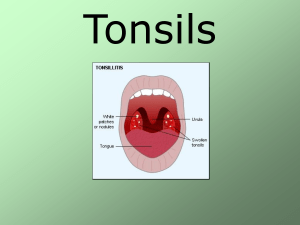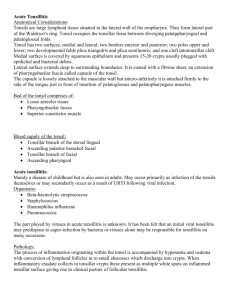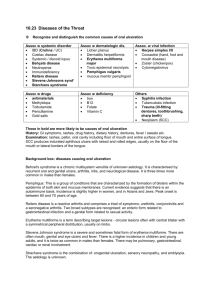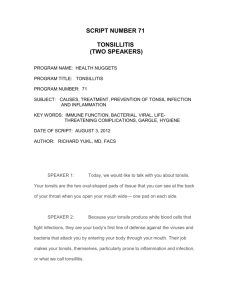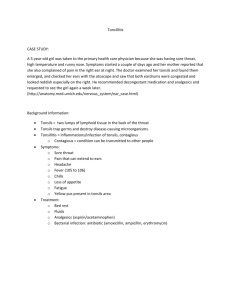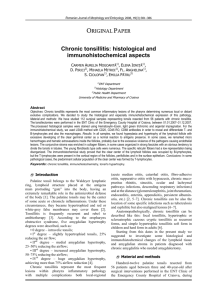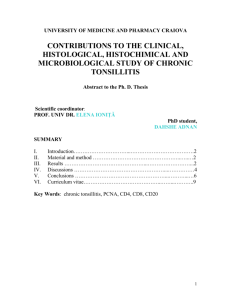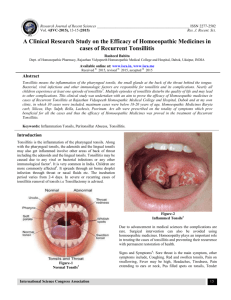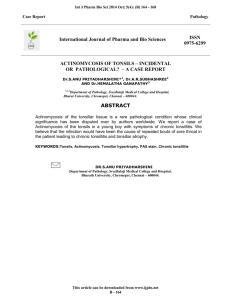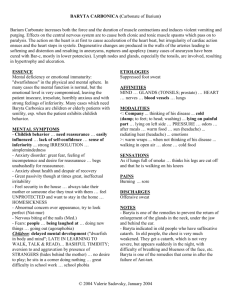ACUTE AND CHRONIC TONSILITIS
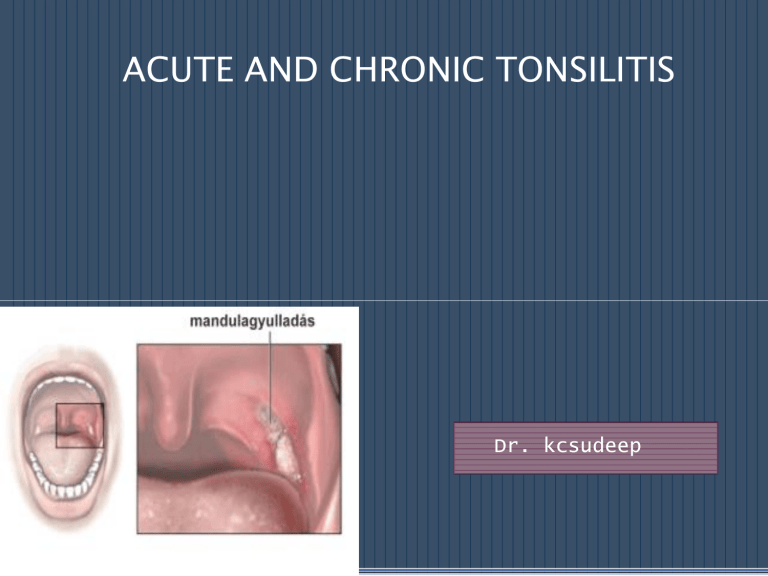
ACUTE AND CHRONIC TONSILITIS
Dr. kcsudeep
ANATOMY:
Palatine tonsils are two in number.
Situated on lateral aspect of oropharynx between the anterior and posterior pillars.
Actual size of the tonsil is bigger than the one that appears from its surface ,as parts tonsil extend upwards into the soft palate, downwards into the base of tongue and anterirly into palatoglossal arch.
Has got medial , lateral surface and upper and lower pole.
Medial surface is covered by non keratinising stratified squamous epithelium which dips into the substance of tonsil in the form of crypts.
Lateral surface is covered by well defined fibrous capsule. In between bed of tonsils and fibrous capsule there is loose areolar tissue site for collection of pus in peritonsillar abscess.
Upper pole of tonsil extends into soft palate and presence of supratonsillar fossa.
Lower pole attached to tongue . Tonsillolingual sulcus may be the seat of carcinoma
Bed of the tonsil: it is formed by superior constrictor and styloglossus muscles.The
glossopharyngeal nerve and styloid process, if enlarged,may lie in relation to the lower part of tonsillar fossa.
BLOOD SUPPLY:
1) Tonsilar branch of facial artery(main artery)
2) Ascending pharyngeal artery from external carotid.
3) Ascending palatine , a branch of facial artery.
4)Dorsal linguae branches of lingual artery.
5) Descending palatine branch of maxillary artery.
VENOUS DRAINAGE: veins from the tonsils drain into paratonsillar vein which joins the common facial vein and pharyngeal venous plexus.
LYMPHATIC DRAINAGE:
• Lymphatics jugulodigastric (tonsillar) node situated below the angle of mandible.
Nerve supply:
• Lesser palatine branches of sphenopalatine ganglion (CNV) and glossopharyngeal nerve provide sensory nerve supply.
Primarily , tonsil consist of a) surface epithelium continous with oropharyngeal lining. b) crypts which are tube like invaginations from surface epithelium.
c) lymphoid tissues.
1) Acute catarrhal or superficial tonsillitis: here tonsillitis is a part of generalised pharyngitis and mostly seen in viral infection.
2) Acute follicular tonsillitis: infection spreads into crypts which become filled with purulent material, presenting at the openings of crypts as yellowish spots.
3) Acute parenchymatous tonsillitis:
Tonsil substance is affected. Tonsil is uniformly enlarged and red.
4)Acute membranous tonsillitis:
It is a stage ahead of acute follicular tonsillitis when exudation from the crypts coalesces to form a membrane on the surface of tonsil.
AETIOLOGY
Mostly affects school-going children, but also affect adults.
Haemolytic streptococcus most common.
Other causes: staphylococci, pneumococci, H. influenza.
SYMPTOMS:
Sore throat.
Difficulty in swallowing.
Fever.
Earache.
Constitutional symptoms headache, malaise, abdominal pain .
SIGNS:
Breath is foetid and tongue is coated.
Hyperaemia of pillars, soft palate and uvula.
Tonsils are red and swollen with yellowish spots of purulent material(acute follicular tonsillitis) or whitis membrane on medial surface of tonsils(acute membranous tonsillitis).
Tonsils may be enlarged or congested so much they almost meet in midline with edema of uvula and soft palate.(acute parenchymatous tonsillitis.)
Jugulodigastric lymphnodes are enlarged and tender.
Laboratory results: blood work indicative of inflammation, an increase in white blood cell count, gradual decrease.
A general examination is necessary, including examination of heart and circulation and urine analysis.
TREATMENT:
Bed rest and plenty of fluids.
Analgesics
Antimicrobial therapy.
COMPLICATIONS:
Chronic tonsillitis with recurrent acute attacks.
Peritonsillar abscess.
Parapharyngeal abscess, cervical abscess.
Rheumatic fever, acute glomerulonephritis, acute otitis media.
FAUCIAL DIPTHERIA
Aetiology : gram positive bacillus, corynebacterium diptheriae.
Spreads by droplet infection.
Incubation period 2-6 days.
CLINICAL FEATURES:
oropharynx is commonly involved and larynx nasal cavity may also be affected.
In oropahryx , a greyish white membrane forms over tonsils .it is tenacious and causes bleeding when removed . cervical lymphnode enlarged giving ‘bullneck” appearance.
Patient is ill and toxemic.
COMPLICATIONS:
Exotoxin produced by this bacilli is toxic to heart and nerves. It cause myocarditis, cardiac arrhythmias and acute circulatory failure.
Neurological complications: paralysis of soft palate, diaphragm and ocular muscles.
In larynx, diptheritic membrane may cause airway obstruction.
Treatment:
Aim is to neutralise free toxins and killing this bacilli.
Check for hypersensitivity.
Diptheria of <48 hrs 20,000 to 40,000 units.
Diptheria of >48hrs and confined to tonsils 80,000 to 120,000 units.
Antibiotics used are benzyl penicillin 600mg 6 hrly for 7 days.
What antibiotics if hypersensitive to benzyl penicillin?
CHRONIC TONSILLITIS:
Aetiology :
May be complication of acute tonsillitis.
Subclinical infections of tonsils without acute attack.
Mostly affect child and young adults.
Chronic infection in sinuses or teeth may be predisposing factor.
TYPES:
Chronic follicular tonsillitis: tonsillar crypts are full of infected cheesy material which shows on surface as yellowish spots.
Chronic parenchymatous tonsillitis: hyperplasia of lymphoid tissue . tonsils are very much enlarged and may interfere with speech, deglutition and respiration.
Chronic fibroid tonsillitis: tonsils are small but infected, with history of repeated sore throats.
CLINICAL FEATURES:
Recurrent attack of sore throat or acute tonsillitis.
Chronic irritation in throat with cough.
Bad taste in mouth and halitosis due to pus in crypts.
Difficulty in swallowing and choking at night.
EXAMINATION:
Tonsils may show varying degree of enlargement.
Yellowish beads of pus on medial surface of tonsil
Flushing of anterior pillars compared to rest of pharyngeal mucosa.
Enlargement of lymphnodes.
TREATMENT:
Conservative treatment: attention to general health, diet, treatment of co-existent infection of teeth, nose and sinuses.
Tonsillectomy is indicated when it interfere with speech, deglutition and respiration or recurrent attack.
COMPLICATIONS:
Peritonsillar abscess.
Parapharyngeal abscess, intra tonsillar abscess.
Tonsilloliths.
Tonsillar cyst.
